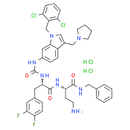Description
RWJ-56110 dihydrochloride is a potent, selective, peptide-mimetic inhibitor of PAR-1 activation and internalization (binding IC50=0.44 uM) and shows no effect on PAR-2, PAR-3, or PAR-4. RWJ-56110 dihydrochloride inhibits the aggregation of human platelets induced by both SFLLRN-NH2 (IC50=0.16 μM) and thrombin (IC50=0.34 μM), quite selective relative to U46619 (HY-108566). RWJ-56110 dihydrochloride blocks angiogenesis and blocks the formation of new vessels in vivo. RWJ-56110 dihydrochloride induces cell apoptosis.
Product information
CAS Number: 2387505-58-8
Molecular Weight: 863.65
Formula: C41H45Cl4F2N7O3
Chemical Name: (2S)-4-amino-N-benzyl-2-[(2S)-2-[({1-[(2, 6-dichlorophenyl)methyl]-3-[(pyrrolidin-1-yl)methyl]-1H-indol-6-yl}carbamoyl)amino]-3-(3, 4-difluorophenyl)propanamido]butanamide dihydrochloride
Smiles: Cl.Cl.NCC[C@H](NC(=O)[C@H](CC1=CC=C(F)C(F)=C1)NC(=O)NC1=CC=C2C(CN3CCCC3)=CN(CC3=C(Cl)C=CC=C3Cl)C2=C1)C(=O)NCC1=CC=CC=C1
InChiKey: MGZSVSHDIOPSBO-ZEUUMAKDSA-N
InChi: InChI=1S/C41H43Cl2F2N7O3.2ClH/c42-32-9-6-10-33(43)31(32)25-52-24-28(23-51-17-4-5-18-51)30-13-12-29(21-38(30)52)48-41(55)50-37(20-27-11-14-34(44)35(45)19-27)40(54)49-36(15-16-46)39(53)47-22-26-7-2-1-3-8-26;;/h1-3,6-14,19,21,24,36-37H,4-5,15-18,20,22-23,25,46H2,(H,47,53)(H,49,54)(H2,48,50,55);2*1H/t36-,37-;;/m0../s1
Technical Data
Appearance: Solid Power
Purity: ≥98% (or refer to the Certificate of Analysis)
Solubility: Soluble in DMSO
Shipping Condition: Shipped under ambient temperature as non-hazardous chemical or refer to Certificate of Analysis
Storage Condition: Dry, dark and -20 oC for 1 year or refer to the Certificate of Analysis.
Shelf Life: ≥360 days if stored properly.
Stock Solution Storage: 0 - 4 oC for 1 month or refer to the Certificate of Analysis.
Drug Formulation: To be determined
HS Tariff Code: 382200
How to use
In Vitro:
Proteinase-activated receptors (PARs) are a family of G protein-coupled receptors activated by the proteolytic cleavage of their N-terminal extracellular domain, exposing a new amino terminal sequence that functions as a tethered ligand to activate the receptors. RWJ56110 inhibits the aggregation of human platelets induced by both SFLLRN-NH2 (IC50=0.16 μM) and thrombin (IC50=0.34 μM) while being quite selective relative to collagen and the thromboxane mimetic U46619 (HY-108566)[1]. RWJ-56110 dihydrochloride is fully inhibits thrombin-induced RASMC proliferation with an IC50 value of 3.5 μM. RWJ-56110 dihydrochloride shows blockade of thrombin’s action with RASMC calcium mobilization (IC50=0.12 μM), as well as with HMVEC (IC50=0.13 μM) and HASMC calcium mobilization (IC50=0.17 μM)[1]. RWJ56110 (0.1-10 μM; 24-96 hours) inhibits endothelial cell growth dose-dependently, with half-maximal inhibitory concentration of RWJ56110 is approximately 10 μM. RWJ56110 (0.1-10 μM; 6 hours) inhibits DNA synthesis of endothelial cells in a thymidine incorporation assays. Endothelial cells are in fast-growing state (50-60% confluence), RWJ56110 inhibits cell DNA synthesis in a dose-dependent manner, but when cells that are in the quiescent state (100% confluent), the inhibitory effect of PAR-1 antagonists is much less pronounced. RWJ56110 (0.1-10 μM; pretreatment for 15 min) inhibits thrombin-induced Erk1/2 activation in a concentration-dependent manner. However, when endothelial cells are stimulated by FBS (final concentration 4%), it reduces partially the activated levels of Erk1/2. RWJ56110 (30 μM; 24 hours) has an inhibitory effect on endothelial cell cycle progression. It reduces the percentage of cells in the S phase, while alterations in the percentages of G1 and G2/M cells are less pronounced.
References:
- Andrade-Gordon, et al.Design, synthesis, and biological characterization of a peptide-mimetic antagonist for a tethered-ligand receptor. oc Natl Acad Sci U S A. 1999 Oct 26;96(22):12257-62.
- Panagiota Zania, et al. Blockade of angiogenesis by small molecule antagonists to protease-activated receptor-1: association with endothelial cell growth suppression and induction of apoptosis. J Pharmacol Exp Ther. 2006 Jul;318(1):246-54.
Products are for research use only. Not for human use.
Payment & Security
Your payment information is processed securely. We do not store credit card details nor have access to your credit card information.


